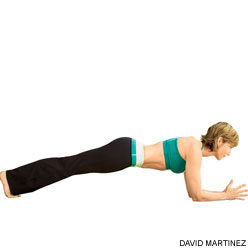 Previously
we discussed the role of the hamstrings and the
psoas muscles
in regard to a painful low back. If tight, both muscle groups have
the ability to pull on the lumbar (lower) spine, creating pain and
even injury*. This week we will discuss the core’s role
in stabilizing the lower spine,
specifically transverse abdominis (or TVA).
Previously
we discussed the role of the hamstrings and the
psoas muscles
in regard to a painful low back. If tight, both muscle groups have
the ability to pull on the lumbar (lower) spine, creating pain and
even injury*. This week we will discuss the core’s role
in stabilizing the lower spine,
specifically transverse abdominis (or TVA).
Transverse abdominis is the deepest layer of abdominal muscles, wrapping around the torso from front to back and from the rib cage to the pelvis. It acts as a corset supporting and stabilizing the low back. We use transverse abdominus without even knowing it when we “suck in” our stomachs to fit into a tight pair of jeans.
Because the muscle is so deep, it is often hard to recognize and isolate. One way to find your TVA is to lie on your back and place your fingers on the inner edges of you hip bones (illiac crest). Exhale deeply with a “ha” sound like you are fogging up a mirror. You should feel a pressing up of the musculature into your finger tips. Try to keep the muscle activated as you breathe. While at first this may seem impossible, it does get easier with practice.

In a healthy system, the brain will activate this deep core muscle before movement in order to support the spine as you move. Once a back injury is acquired, however, it is believed that the brain experiences a “short-circuit” in a way, and forgets to activate those muscles before movement, which can in turn lead to further instability and injury. In this circumstance, retraining of transverse abdominis may be necessary.
 An
extremely effective exercise to strengthen the transverse
abdominis
is a simple plank pose. Take your elbows onto the ground
shoulder-distance, stack your shoulders directly over your elbows,
draw your belly button towards your spine, lift your knees away
from the ground and lower your hips in the same line as your
shoulders. Hold for 30-90 seconds. You could also start by keeping
the knees on the ground. This option can still be a challenge and
is a great place to build from.
An
extremely effective exercise to strengthen the transverse
abdominis
is a simple plank pose. Take your elbows onto the ground
shoulder-distance, stack your shoulders directly over your elbows,
draw your belly button towards your spine, lift your knees away
from the ground and lower your hips in the same line as your
shoulders. Hold for 30-90 seconds. You could also start by keeping
the knees on the ground. This option can still be a challenge and
is a great place to build from.
As you move through your yoga practice, you will need to remind yourself to activate this muscle at first. Eventually with time and practice, the TVA will automatically activate without much thought. Although it requires awareness and work, the payoff is a deep sense of strength from within, allowing you to access poses you never thought possible.
The biggest payoff of all? A healthy and pain free back!
Good luck in your endeavors towards a healthy and happy back.
- Jacci Collins is a yoga instructor, dancer and blogger living in Vancouver, BC. A lifelong student of yoga, she strives to find balance in the body and mind with humor and grace. Join her at www.jaccicollinsyoga.com, facebook, and twitter.


Comments
Existing Comments